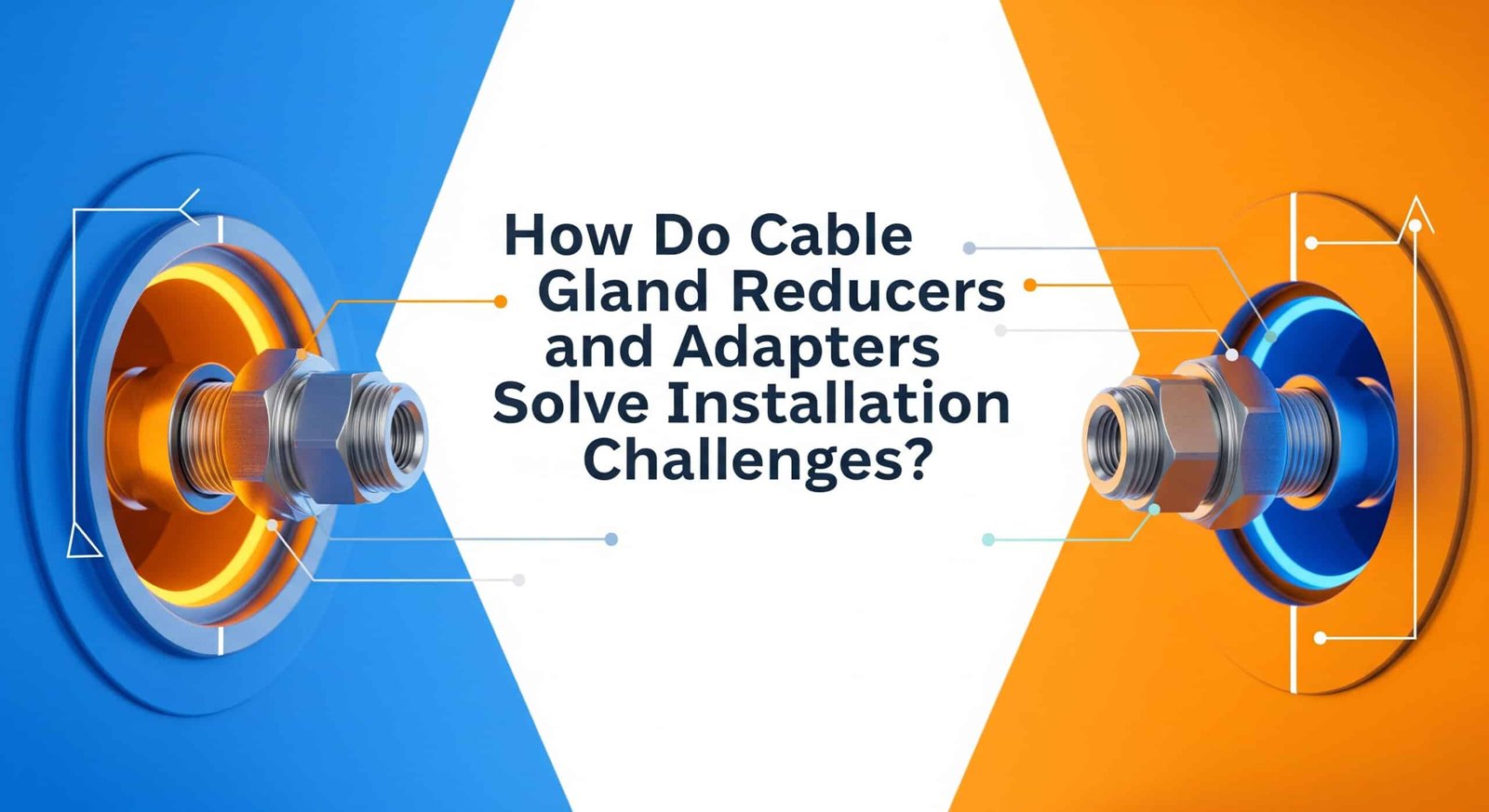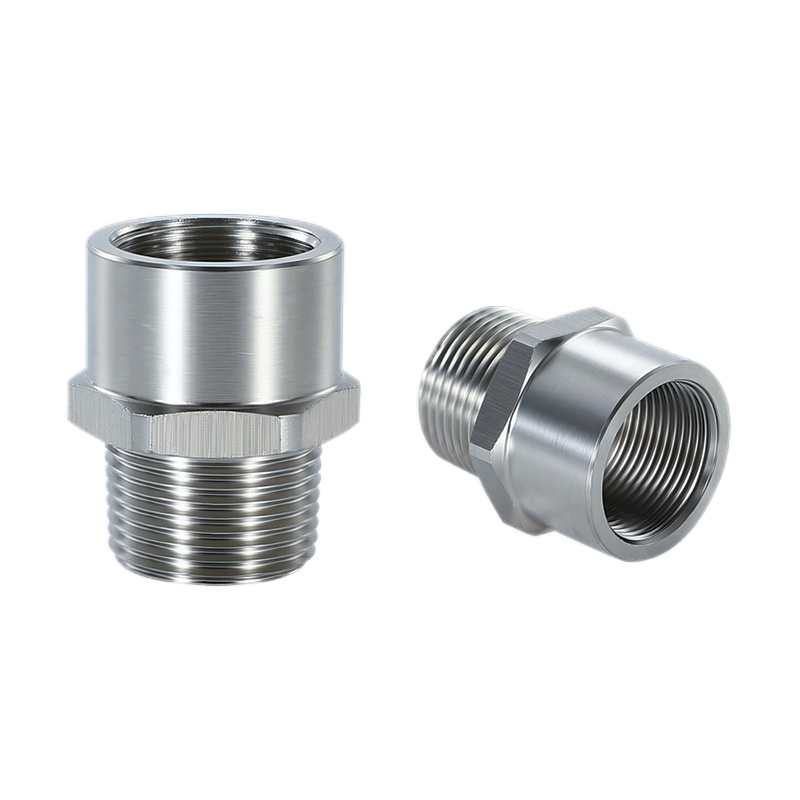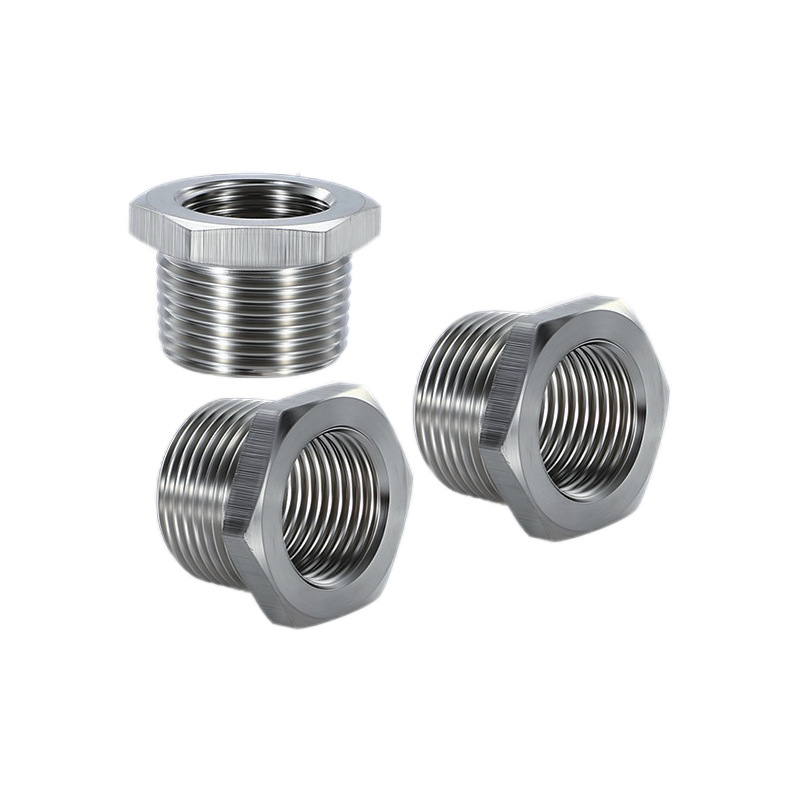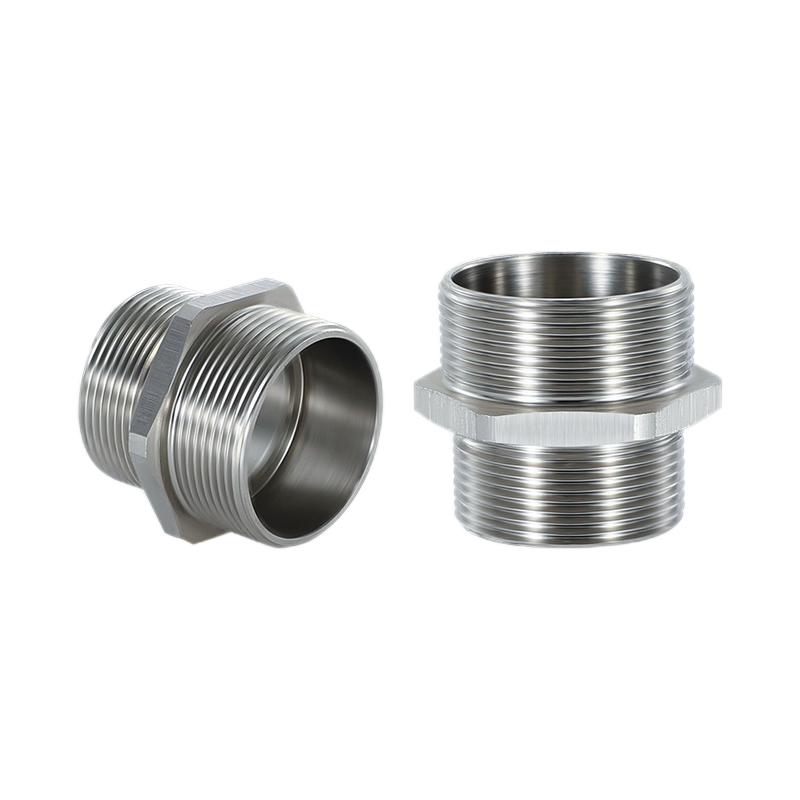Installation delays and costly rework plague electrical projects when cable glands don’t match existing equipment threads or cable sizes, forcing engineers to source new components, modify panels, or compromise installation quality with makeshift solutions that create safety hazards and compliance issues. Many contractors underestimate the complexity of thread compatibility and cable sizing, leading to project delays, budget overruns, and frustrated customers when standard cable glands won’t fit their specific installation requirements.
Cable gland reducers and adapters provide flexible solutions for thread size conversion, cable diameter adjustment, and equipment compatibility by offering metric-to-NPT thread conversion, cable size reduction capabilities, and equipment mounting adaptations that eliminate the need for panel modifications or custom components. These accessories enable standard cable glands to work in non-standard applications while maintaining sealing integrity and regulatory compliance.
Having worked with electrical contractors, panel builders, and maintenance teams across North America, Europe, and Asia—from automotive plants in Detroit to offshore platforms in the North Sea—I’ve seen how proper reducer and adapter selection can transform challenging installations into straightforward solutions. Let me share the essential knowledge every professional needs for using these critical accessories effectively.
Table of Contents
- What Are Cable Gland Reducers and Adapters Used For?
- Which Types of Reducers and Adapters Are Available?
- How Do You Select the Right Reducer or Adapter for Your Application?
- What Are the Installation Best Practices for Cable Gland Accessories?
- How Do You Maintain Sealing and Compliance When Using Adapters?
- FAQs About Cable Gland Reducers and Adapters
What Are Cable Gland Reducers and Adapters Used For?
Cable gland reducers and adapters solve installation compatibility problems by converting thread sizes, adjusting cable diameter ranges, and enabling equipment integration when standard cable glands don’t match existing infrastructure, eliminating the need for costly panel modifications or custom components.
Understanding these applications is crucial because the right accessories can save significant time and money while maintaining installation quality and safety standards.
Thread Size Conversion Applications
Metric to NPT Conversion: Converting between metric (M12, M16, M20, M25) and NPT (1/2″, 3/4″, 1″) thread systems for international equipment compatibility and mixed-standard installations.
Size Step-Down Solutions: Using larger equipment holes with smaller cable glands when panel modifications aren’t feasible or cost-effective for retrofit applications.
Legacy Equipment Integration: Adapting modern cable glands to older equipment with non-standard or obsolete thread specifications that are no longer commercially available.
Multi-Standard Projects: Enabling consistent cable gland specifications across projects that involve equipment from different manufacturers with varying thread standards.
Cable Diameter Adjustment
Oversized Cable Accommodation: Reducing cable gland entry sizes to properly seal smaller cables without compromising sealing effectiveness or strain relief performance.
Multi-Cable Applications: Creating proper sealing around multiple small cables passing through single larger gland entries for cost-effective installations.
Cable Bundling Solutions: Adapting cable glands for bundled cable installations where individual cable diameters are smaller than optimal gland sizing.
Flexible Cable Management: Providing adjustment capability for installations where final cable sizes may vary during construction or future modifications.
Equipment Compatibility Solutions
Panel Thickness Adaptation: Adjusting cable gland mounting for panels with non-standard thickness that don’t match standard gland thread lengths.
Mounting Surface Irregularities: Compensating for uneven or angled mounting surfaces that prevent proper cable gland installation and sealing.
Space Constraint Solutions: Enabling cable gland installation in tight spaces where standard glands won’t fit due to clearance limitations.
Retrofit Applications: Adapting new cable glands to existing installations without requiring extensive modifications to equipment or infrastructure.
I remember working with Jennifer, a maintenance manager at a major automotive plant in Stuttgart, Germany. During a production line upgrade, her team needed to install new control cables but discovered the existing German equipment used M25 threads while their standard cable glands were NPT 3/4″. Rather than modifying dozens of expensive control panels or sourcing custom cable glands, we provided M25-to-NPT adapters that enabled them to use their standard inventory. The solution saved three weeks of downtime and over €50,000 in panel modifications while maintaining full IP65 sealing performance1. 😊
Cost and Time Savings Benefits
Inventory Standardization: Reducing cable gland inventory requirements by using adapters to make standard sizes work across multiple applications and equipment types.
Installation Flexibility: Providing field adjustment capability that reduces pre-planning requirements and accommodates unexpected installation challenges.
Maintenance Efficiency: Enabling use of standard replacement parts even when original equipment specifications don’t match current inventory or supplier offerings.
Project Risk Mitigation: Reducing project delays caused by component compatibility issues or long lead times for custom or non-standard cable glands.
Which Types of Reducers and Adapters Are Available?
Cable gland reducers and adapters include thread conversion adapters, cable diameter reducers, mounting adapters, and specialized accessories that address specific installation challenges while maintaining sealing integrity and regulatory compliance across different applications.
Understanding available options helps select the most appropriate solution for specific installation requirements and compatibility challenges.
Thread Conversion Adapters
Metric to NPT Adapters: Standard conversions including M12-to-1/2″, M16-to-1/2″, M20-to-3/4″, M25-to-3/4″, and M32-to-1″ for common international compatibility requirements.
NPT to Metric Adapters: Reverse conversions for installing metric cable glands in NPT-threaded equipment, particularly useful for European equipment in North American installations.
Custom Thread Adapters: Specialized adapters for unusual thread combinations, legacy equipment, or specific manufacturer requirements that aren’t covered by standard offerings.
Step-Up Adapters: Converting smaller threads to larger sizes when oversized holes need to accommodate smaller cable glands without compromising installation integrity.
Cable Diameter Reducers
Insert Reducers: Polymer or rubber inserts that reduce cable gland entry diameter while maintaining sealing effectiveness for smaller cables.
Compression Reducers: Mechanical reducers that provide adjustable compression sealing for cables smaller than the gland’s designed range.
Multi-Hole Reducers: Specialized reducers with multiple small holes for sealing several small cables through a single larger cable gland entry.
Progressive Reducers: Step-down reducers that accommodate multiple cable sizes within a single adapter for flexible installation options.
Mounting and Extension Adapters
Panel Thickness Adapters: Extending or reducing effective thread length to accommodate panels with non-standard thickness requirements.
Angled Adapters: Providing angular adjustment for cable entries that need to approach at angles other than perpendicular to the mounting surface.
Extension Adapters: Adding length to cable gland installations for thick panels, insulated surfaces, or clearance requirements.
Flange Adapters: Converting threaded cable glands to flange-mount configurations for specific equipment or installation requirements.
Specialized Application Adapters
| Adapter Type | Primary Use | Thread Range | Material Options | IP Rating |
|---|---|---|---|---|
| Metric-NPT2 | International compatibility | M12-M32 to 1/2″-1″ | Brass, SS, Nylon | IP65-IP68 |
| Cable Reducer | Size adjustment | 3-25mm cable range | EPDM, Silicone | IP65-IP68 |
| Panel Extension | Thick panels | 5-50mm extension | Brass, Stainless | IP65-IP68 |
| Multi-Cable3 | Multiple cables | 2-8 cable entries | Nylon, TPE | IP54-IP65 |
Material Compatibility: Adapters are available in materials matching cable gland specifications including brass, stainless steel, nylon, and specialized polymers for chemical resistance.
Sealing Performance: Quality adapters maintain the same IP rating as the base cable gland when properly installed with appropriate sealing compounds and techniques.
How Do You Select the Right Reducer or Adapter for Your Application?
Selecting cable gland reducers and adapters requires analyzing thread compatibility, cable specifications, environmental conditions, and installation constraints while ensuring maintained sealing performance and regulatory compliance for the specific application.
Proper selection ensures optimal performance while avoiding compatibility issues or installation problems that could compromise system reliability.
Thread Compatibility Analysis
Equipment Thread Identification: Accurately identifying existing equipment thread specifications including size, pitch, and standard (metric vs. NPT) to ensure proper adapter selection.
Cable Gland Specifications: Verifying cable gland thread specifications and sealing requirements to select compatible adapters that maintain performance characteristics.
Thread Engagement Requirements: Ensuring adequate thread engagement for both adapter-to-equipment and gland-to-adapter connections to maintain mechanical integrity and sealing.
Tolerance Considerations: Accounting for manufacturing tolerances in both equipment and adapters to ensure reliable fit and sealing performance across production variations.
Cable Specification Requirements
Cable Diameter Range: Measuring actual cable outer diameter including any sheathing, armor, or protective coverings to select appropriate reducer sizing.
Cable Type Considerations: Considering cable flexibility, armor requirements, and strain relief needs when selecting reducers that accommodate specific cable characteristics.
Multi-Cable Applications: Planning for multiple cable installations including cable spacing, bundling requirements, and individual sealing needs for complex installations.
Future Expansion: Considering potential cable additions or changes that might affect reducer selection and installation planning for long-term flexibility.
Environmental and Performance Factors
Sealing Requirements: Matching adapter sealing capabilities to application requirements including IP ratings, pressure resistance, and environmental exposure conditions.
Material Compatibility: Selecting adapter materials that are compatible with installation environment including chemical exposure, temperature ranges, and UV resistance requirements.
Mechanical Stress: Evaluating installation stresses including vibration, thermal cycling, and mechanical loads that could affect adapter performance and longevity.
Regulatory Compliance: Ensuring selected adapters maintain required certifications and compliance with relevant standards for the specific application and industry.
Installation Constraint Evaluation
Space Limitations: Assessing available installation space including clearance requirements for adapter installation and future maintenance access.
Panel Thickness: Measuring actual panel thickness and considering insulation or coating thickness that might affect adapter selection and installation requirements.
Access Requirements: Considering installation and maintenance access limitations that might affect adapter type selection and installation procedures.
Tool Requirements: Evaluating special tools or installation equipment needed for specific adapter types and ensuring availability for installation teams.
Marcus, who manages electrical installations for a major chemical plant in Houston, Texas, faced challenges when upgrading control systems that mixed European and American equipment. The European control panels used M20 threads while their standard cable glands were NPT 3/4″. After analyzing the installation requirements including chemical resistance, temperature exposure, and maintenance access, we recommended stainless steel M20-to-NPT adapters with PTFE sealing for the harsh chemical environment. The solution enabled standardized cable gland inventory while meeting all safety and environmental requirements for the facility.
What Are the Installation Best Practices for Cable Gland Accessories?
Proper installation of cable gland reducers and adapters requires careful preparation, correct sealing techniques, appropriate torque application, and systematic testing to ensure reliable performance and maintained IP ratings throughout the system lifecycle.
Following best practices is essential because improper installation can compromise sealing effectiveness and create safety hazards even with high-quality components.
Pre-Installation Preparation
Component Inspection: Thoroughly inspecting all adapters, reducers, and sealing components for damage, contamination, or defects before installation begins.
Thread Preparation: Cleaning and preparing all threaded surfaces to remove contamination, old sealant, or corrosion that could prevent proper sealing or engagement.
Sealing Material Selection: Choosing appropriate thread sealants, gaskets, or O-rings based on environmental conditions and compatibility with system components.
Tool Preparation: Ensuring proper tools are available including appropriate wrenches, torque tools, and measuring equipment for accurate installation.
Installation Sequence and Techniques
Adapter Installation Order: Installing adapters before cable glands to ensure proper thread engagement and sealing without interference from cables or other components.
Sealing Compound Application: Applying thread sealant or installing gaskets according to manufacturer specifications to ensure proper sealing without over-application that could cause problems.
Thread Engagement: Ensuring adequate thread engagement (minimum 3-5 threads) for both adapter connections while avoiding over-tightening that could damage components.
Alignment Verification: Verifying proper alignment of all components before final tightening to prevent binding, cross-threading, or sealing problems.
Torque and Tightening Procedures
Torque Specifications: Following manufacturer torque specifications4 for both adapter-to-equipment and gland-to-adapter connections to ensure proper sealing without component damage.
Sequential Tightening: Tightening connections in proper sequence to ensure even sealing pressure and prevent component distortion or misalignment.
Torque Verification: Using calibrated torque tools to verify proper tightening and documenting torque values for quality control and future maintenance reference.
Final Inspection: Conducting visual inspection of all connections to verify proper installation, alignment, and absence of damage or contamination.
Cable Installation Considerations
Cable Preparation: Properly preparing cables including cleaning, measuring, and applying any required protective coverings before installation through reducers.
Strain Relief: Ensuring adequate strain relief for cables passing through reducers to prevent damage to sealing elements or cable conductors.
Sealing Verification: Verifying proper sealing around cables using appropriate testing methods to confirm IP rating performance is maintained.
Documentation: Recording installation details including component specifications, torque values, and test results for future maintenance and troubleshooting reference.
How Do You Maintain Sealing and Compliance When Using Adapters?
Maintaining sealing and compliance with cable gland adapters requires understanding how accessories affect IP ratings, ensuring proper certification documentation, conducting appropriate testing, and implementing systematic maintenance procedures throughout the system lifecycle.
Proper compliance management is critical because adapters can affect system certifications and safety performance if not properly specified and maintained.
IP Rating Considerations
Rating Preservation: Understanding how adapters affect overall IP ratings and ensuring the complete assembly maintains required sealing performance for the application.
Sealing Chain Analysis: Analyzing the complete sealing path from equipment to cable including all interfaces and potential leak points in the adapter assembly.
Testing Requirements: Conducting appropriate pressure and water ingress testing to verify maintained IP ratings after adapter installation.
Documentation Requirements: Maintaining complete documentation of IP rating performance for the complete assembly including all adapters and accessories.
Certification and Compliance Management
Component Certifications: Ensuring all adapters and reducers carry appropriate certifications for the intended application including hazardous area, marine, or food-grade requirements.
System Certification: Understanding how adapters affect overall system certifications and ensuring compliance with relevant standards and regulations.
Documentation Control: Maintaining complete certification documentation for all components including adapters, reducers, and sealing materials used in the installation.
Change Management: Implementing procedures for evaluating and approving adapter changes that might affect system compliance or performance.
Maintenance and Inspection Procedures
Regular Inspection: Establishing inspection schedules for adapter assemblies including visual inspection, sealing verification, and mechanical integrity checks.
Preventive Maintenance: Implementing preventive maintenance procedures including seal replacement, thread inspection, and torque verification at appropriate intervals.
Performance Monitoring: Monitoring system performance indicators that might indicate adapter problems including moisture ingress, electrical faults, or mechanical failures.
Replacement Planning: Planning for adapter replacement based on service life expectations, environmental exposure, and maintenance history to prevent unexpected failures.
Quality Assurance Programs
Installation Standards: Establishing and maintaining installation standards for adapter applications including procedures, materials, and quality control requirements.
Training Programs: Ensuring installation and maintenance personnel receive appropriate training on adapter applications, installation procedures, and compliance requirements.
Supplier Qualification: Maintaining qualified supplier programs for adapters and accessories to ensure consistent quality and performance across all installations.
Performance Tracking: Tracking adapter performance across installations to identify trends, optimize specifications, and improve maintenance procedures.
Hassan, who owns a large food processing facility in Dubai, UAE, learned the importance of systematic compliance management when health inspectors questioned the use of adapters in their washdown areas. His maintenance team had properly installed stainless steel adapters but lacked complete documentation of IP69K compliance5 for the complete assembly. After implementing our recommended documentation and testing procedures, including pressure testing of complete adapter assemblies and maintaining detailed certification records, the facility achieved full regulatory compliance and passed all subsequent inspections. The systematic approach prevented potential production shutdowns and maintained their food safety certifications.
Conclusion
Cable gland reducers and adapters provide essential solutions for installation compatibility challenges while maintaining sealing performance and regulatory compliance. Success requires understanding available options, proper selection based on application requirements, following installation best practices, and maintaining systematic compliance management throughout the system lifecycle.
The key to effective adapter use lies in treating them as integral system components rather than simple accessories, ensuring they meet the same performance and quality standards as the primary cable glands. At Bepto, we provide comprehensive reducer and adapter solutions including thread conversion adapters, cable diameter reducers, and specialized accessories to help customers solve installation challenges while maintaining system integrity. Our engineering team understands the complex interactions between adapters and system performance, helping you select the right solutions for your specific applications.
FAQs About Cable Gland Reducers and Adapters
Q: Do cable gland adapters affect IP ratings?
A: Quality adapters maintain the same IP rating as the base cable gland when properly installed with appropriate sealing materials. The complete assembly must be tested and certified to ensure the IP rating is preserved through all connection points.
Q: Can I use multiple adapters together?
A: Multiple adapters can be used together but each additional connection point increases potential leak paths and reduces reliability. It’s better to use a single adapter that achieves the required conversion when possible for optimal performance.
Q: What’s the difference between reducers and adapters?
A: Reducers adjust cable diameter ranges within the same thread size, while adapters convert between different thread sizes or mounting methods. Some products combine both functions for comprehensive installation flexibility.
Q: How do I know if my adapter installation is properly sealed?
A: Proper sealing can be verified through pressure testing, visual inspection of sealing materials, and checking for proper torque application. Professional installations should include documented testing to verify IP rating performance.
Q: Are there size limits for cable gland adapters?
A: Most standard adapters work within common size ranges (M12-M32, 1/2″-1″ NPT), but custom adapters are available for unusual applications. Larger size conversions may require specialized adapters or alternative mounting solutions for optimal performance.
-
Understand the specific testing standards for the IP65 rating against dust and water jets. ↩
-
View a detailed chart for converting between metric and NPT thread sizes. ↩
-
Explore a guide on multi-cable sealing solutions for high-density installations. ↩
-
Learn the engineering principles of torque control for achieving a reliable seal. ↩
-
Read the testing requirements for the IP69K rating for high-pressure, high-temperature cleaning. ↩





